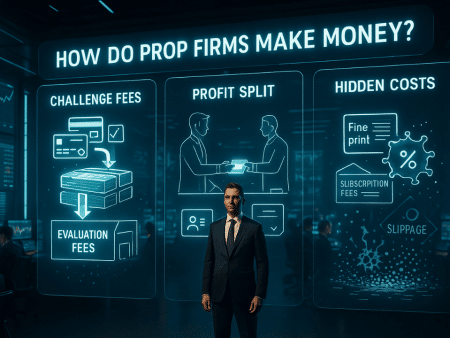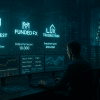Table of Contents
ToggleWhat is Institutional Forex Trading?
Institutional forex trading is the heavyweight division of the currency market where the largest players operate with billion-dollar capital at their disposal. Unlike retail forex trading, which focuses on smaller, individual moves, institutional trading involves vast sums of money, sophisticated algorithms, and access to market data that most retail traders do not have.
Think of it this way: if retail traders are playing chess in the park, institutional traders are running a NASA-level mission where every move is backed by data, high-speed execution, and teams of analysts monitoring economic indicators in real time.
Here is what sets it apart:
- Capital Power: Large trades can move markets, providing liquidity but also the potential for rapid price shifts.
- Advanced Infrastructure: Access to co-located servers, interbank networks, and premium data feeds.
- Professional Risk Management: Institutions use quantitative risk models and strict compliance oversight to avoid catastrophic losses.
- Strategic Edge: Combining macroeconomic analysis with technical models to predict currency flows.
Why It Matters: For retail traders, understanding how institutions operate is like getting a behind-the-scenes look at a magic show. It demystifies price moves and reveals patterns that can be tracked and potentially used for profit.
Who Are Institutional Forex Traders?
Institutional forex traders are financial professionals who operate on behalf of large organizations such as central banks, hedge funds, investment banks, pension funds, and multinational corporations. These traders are often referred to as the market movers because their decisions can shape entire trends in the currency market.
Here are the primary categories of institutional traders and how they influence the market:
- Central Banks
Central banks, such as the Federal Reserve or the European Central Bank, participate in the forex market primarily to stabilize their national currency and control inflation. Their trades often have an immediate and significant impact on exchange rates. For example, a central bank may buy or sell large amounts of its currency to influence its value relative to other currencies. - Hedge Funds
Hedge funds are private investment pools that employ aggressive and often highly leveraged strategies to generate returns. In forex, they take advantage of macroeconomic trends, currency arbitrage, and volatility spikes. Some specialize in macro strategies that follow broad economic indicators, while others focus on relative value trades between currency pairs. - Investment and Mutual Fund Managers
These managers oversee large pools of capital and allocate funds across multiple asset classes, including currencies. Mutual fund managers often have a longer-term focus, while investment fund managers may take more tactical positions to capture short-term profit opportunities in the forex market. Their capital movements can significantly influence currency valuations. - Pension Fund Managers
Pension funds manage retirement savings for millions of people. While forex trading is not their primary objective, they often hedge currency exposure when investing internationally. This helps protect the value of the fund from adverse currency movements and ensures long-term stability for retirees. - Investment Banks
Major investment banks such as Goldman Sachs and JPMorgan Chase act as both traders and market makers in forex. They provide liquidity for corporate clients, manage currency risk, and execute large-scale trades. They employ specialist traders who combine decades of market experience with advanced trading infrastructure to maintain a competitive advantage.
Why This Matters to Retail Traders: By identifying the strategies and timing of these institutional players, retail traders can better anticipate major price shifts. Knowing who is moving the market helps in aligning trades with strong trends rather than being caught on the wrong side of a large position change.
Types of Institutional Forex Traders
Institutional forex trading strategies vary depending on the type of organization involved. Each group has distinct objectives, risk tolerances, and trading methods. Understanding these differences is essential for recognizing market patterns and anticipating currency movements.
Hedge Funds
Hedge funds are private investment pools that use a wide range of aggressive trading strategies designed to maximize returns. In forex trading, hedge funds often rely on leverage, complex derivatives, and advanced analytics to exploit price fluctuations.
Some hedge funds, known as macro funds, follow large-scale economic trends such as interest rate changes or geopolitical events. Others, known as relative value funds, search for price discrepancies between related currency pairs and execute trades to capture these differences. The speed and precision with which hedge funds act can influence short-term currency volatility.
Investment and Mutual Fund Managers
Investment and mutual fund managers oversee substantial capital pools that are invested across various asset classes, including foreign exchange markets.
Mutual fund managers usually have a long-term focus, holding positions for months or even years. They tend to prioritize stability and consistent returns. Investment fund managers, on the other hand, may take a more active role in forex, entering and exiting positions strategically to take advantage of short-term opportunities.
The decisions made by these managers can influence currency demand, especially when they reallocate capital between domestic and international markets.
Pension Fund Managers
Pension funds are responsible for safeguarding the retirement savings of millions of individuals. While forex trading is not their primary focus, they often use currency hedging strategies to protect their assets from exchange rate risk.
For example, if a pension fund holds investments in foreign markets, sudden changes in currency value could reduce the returns when converted back to the domestic currency. By using forex hedging, pension fund managers help ensure that retirees’ savings are not eroded by unfavorable exchange rate movements.
Investment Banks
Large investment banks such as JPMorgan Chase, Goldman Sachs, and Citigroup are major players in the forex market. They act as market makers by quoting both buy and sell prices for currency pairs, thereby providing liquidity to the market.
These institutions also help corporate clients manage currency exposure, execute cross-border transactions, and hedge against exchange rate risk. Many investment banks have specialized trading desks staffed with highly experienced professionals who use advanced algorithms, economic models, and global market intelligence to maintain a competitive edge.
Key Takeaway: Each type of institutional trader has its own motivations, but all share one thing in common: their activity significantly shapes forex market trends. By understanding the role and behavior of each group, retail traders can better position themselves to align with market momentum.
Advantages and Disadvantages of Institutional Forex Trading
Institutional forex trading offers clear benefits that make it a powerful force in the currency markets. However, it also comes with challenges that can limit flexibility and increase operational complexity. By understanding both sides, traders can gain a balanced perspective on how institutions function and why their approach differs from retail trading.
Advantages of Institutional Trading
Access to Superior Liquidity
Institutions can execute large trades without causing significant price slippage. Their deep market access allows them to enter and exit positions more efficiently than smaller traders.Better Pricing
Due to their high trading volumes, institutions often receive more favorable bid-ask spreads from liquidity providers, which directly reduces transaction costs.Specialized Tools and Technology
Institutions employ state-of-the-art trading platforms, advanced analytics, and proprietary research systems that give them a competitive edge in decision-making.Influence Over Market Conditions
Large institutions can, in some cases, move prices in their favor by placing strategic orders, creating opportunities for profit that retail traders cannot replicate.
Challenges Faced by Institutional Traders
Regulatory Constraints
Institutions are heavily regulated by financial authorities, which can slow down decision-making and limit certain trading activities.Execution Risk
Large orders can move the market against the trader, making execution timing critical. This is especially challenging in periods of low liquidity or high volatility.Operational Complexity
Many institutions operate using a hub-and-spoke model with multiple trading desks and regional teams. Coordinating activities across different locations can be costly and time-consuming.Ethical Considerations
Institutional traders must adhere to strict ethical standards. Any breach can result in reputational damage, regulatory penalties, and loss of client trust.
Takeaway:
Institutional trading offers unmatched resources and influence, but it comes with strict oversight, operational challenges, and significant responsibility. Retail traders can learn from these strengths while also appreciating the flexibility they enjoy without such constraints.
Identifying Institutional Forex Trades
Spotting institutional activity in the forex market can give retail traders an important edge. Large players often leave behind telltale signs in price action, volume, and order flow. By learning to recognize these signals, traders can align their strategies with the market’s most influential participants rather than trading against them.
Tools and Indicators for Spotting Institutional Activity
Volume Analysis
Sudden spikes in trading volume often suggest that large institutions are entering or exiting the market. While forex is decentralized and does not have a central exchange volume report, many platforms provide tick volume data that can help identify unusual activity.Order Flow
Order flow tools display buying and selling activity in real time. A sharp imbalance between buy and sell orders can signal that institutional traders are building or reducing positions.Commitment of Traders (COT) Report
Published weekly by the U.S. Commodity Futures Trading Commission (CFTC), this report details the positions of institutional traders in the futures markets. Reviewing it can help identify long-term positioning trends in major currency pairs.
Price Patterns and Market Behavior
Institutional trades often produce specific market reactions that can be recognized by trained eyes:
Breakouts from Consolidation
When a currency pair has been trading in a tight range and suddenly breaks out with strong momentum, it is often a sign that institutions have entered the market.Reactions to Support and Resistance Levels
Large buy or sell orders at significant technical levels can reinforce these areas as key decision points for future trades.Price Gaps and Sharp Moves After News
A sudden price gap or a rapid move immediately after a major economic release can signal institutional involvement. Institutions are often first to react to new data, creating sharp and immediate market adjustments.
Pro Tip: Retail traders who combine technical analysis with institutional tracking tools can improve their timing and reduce the risk of entering trades just as a major player is about to move the market in the opposite direction.
Popular Institutional Forex Trading Strategies
Institutional traders use strategies that are carefully designed for scale, efficiency, and profitability. These approaches are supported by cutting-edge technology, extensive market research, and a deep understanding of macroeconomic factors. While some of these methods are beyond the reach of most retail traders, understanding them can help identify opportunities to follow the market’s largest players.
Trend Following
Trend following is one of the most widely used institutional strategies. The goal is to capture sustained price movements in a particular direction, whether upward or downward.
Institutions often use advanced algorithms to scan global markets for early signs of a trend. This can include moving average crossovers, higher highs and higher lows in an uptrend, or lower highs and lower lows in a downtrend. In addition to technical signals, institutions incorporate macroeconomic indicators such as GDP growth rates, employment figures, and central bank policies to confirm the strength of a trend.
Arbitrage
Arbitrage involves profiting from price discrepancies between related markets or instruments. Institutional traders employ extremely fast execution systems to capitalize on these opportunities before they disappear.
One example is triangular arbitrage, where differences in exchange rates between three currency pairs create a short-lived profit opportunity. Institutions execute all legs of the trade within fractions of a second, locking in risk-free gains.
Market Making
Market making involves quoting both buy and sell prices for a currency pair, thereby providing liquidity to other market participants. Institutions that act as market makers profit from the spread between these prices.
This strategy requires large amounts of capital, a deep understanding of order flow, and the ability to manage risk in real time. Market makers help maintain stability in the market while also generating consistent profits from transaction volume.
High-Frequency Trading (HFT)
High-frequency trading uses algorithms to execute thousands of trades per second, often taking advantage of small price inefficiencies. Institutions that employ HFT strategies invest heavily in low-latency systems, sometimes placing their servers physically close to exchange data centers to reduce transmission time.
While HFT can be highly profitable, it requires significant technological investment and specialized expertise, making it impractical for most retail traders.
Key Insight: By understanding these institutional strategies, retail traders can better interpret market movements and avoid trading against powerful, well-capitalized players. Even if a retail trader cannot replicate these strategies exactly, awareness of them can provide an important competitive advantage.
Backtesting and Analyzing Institutional Forex Strategies
Backtesting is a critical process in institutional forex trading. It allows traders to evaluate how a strategy would have performed in the past, using historical market data to assess its profitability, risk, and consistency. This step helps institutions refine their methods before committing large amounts of capital in live markets.
Importance of Backtesting
Backtesting offers several advantages for institutional traders:
Risk Assessment
By simulating a strategy’s performance across different market conditions, traders can identify potential weaknesses and estimate worst-case losses.Optimization
Institutions can fine-tune strategy parameters, such as trade entry points, stop-loss placements, and position sizes, to improve efficiency.Confidence Building
Seeing positive historical results can give traders the confidence to deploy a strategy at scale, while poor results can signal the need for adjustments.
Tools for Backtesting Forex Strategies
Institutions use powerful platforms for backtesting, often integrated with proprietary systems. Some of the most popular tools include:
MetaTrader 4 and MetaTrader 5
Widely used trading platforms that allow full backtesting functionality with custom scripts and expert advisors.QuantConnect
A robust platform designed for algorithmic strategy testing, offering extensive data libraries and coding flexibility.TradingView
A charting platform with built-in backtesting capabilities, ideal for testing technical strategies against historical data.
Many institutions also combine these platforms with custom-built analytics systems that can process massive datasets and integrate economic indicators for a more comprehensive analysis.
Real-World Example
An investment bank might backtest a currency hedging strategy to see how it would have performed during periods of extreme volatility, such as during a central bank policy announcement or a geopolitical crisis. By studying the results, the bank could adjust its risk limits, trade timing, or currency allocation to achieve better long-term performance.
Pro Tip: Retail traders can also apply backtesting to their own strategies, even if they do not have access to institutional-grade technology. The key is to use reliable historical data, test across different market environments, and remain objective when analyzing results.
Institutional Forex Trading Charts and Tools
One of the biggest advantages institutional traders have over retail participants is access to advanced charting systems and analytical tools. These resources allow them to make faster, more accurate decisions and identify opportunities before they are visible to the broader market.
Where to Find Institutional Forex Charts
Institutions rely on high-quality, real-time data from trusted providers. Some of the most widely used sources include:
Bloomberg Terminal
Offers comprehensive market data, customizable charting, news feeds, and access to exclusive economic reports.Thomson Reuters Eikon
Provides real-time currency data, advanced analytics, and a global network of financial news and insights.TradingView
While also popular among retail traders, TradingView is used by some institutions for its advanced charting tools, community insights, and flexibility in customizing indicators.
These platforms often combine price charts with macroeconomic data, giving institutional traders a more complete view of market conditions.
Key Tools Used by Institutional Traders
Algorithmic Trading Platforms
Allow automated execution of complex strategies, often across multiple markets and instruments simultaneously.Economic Models
Use historical and current data to forecast macroeconomic trends that influence currency prices.High-Frequency Data Feeds
Deliver market information with minimal delay, allowing traders to act on opportunities the moment they appear.
Why It Matters for Retail Traders
While most retail traders do not have access to the full range of institutional tools, they can still benefit by using high-quality charting platforms, real-time news feeds, and accurate economic calendars. Adopting even a fraction of the professional toolkit can significantly improve trade timing and analysis.
Conclusion
Summary of Key Insights
Institutional forex trading differs from retail trading in scale, strategy complexity, and overall market impact. Institutions operate with vast amounts of capital, advanced analytical tools, and the ability to influence price movements through large orders. Their decisions are informed by a combination of technical, fundamental, and macroeconomic factors, allowing them to maintain a strategic edge.
For retail traders, understanding how institutions operate provides valuable perspective. It helps explain sudden price movements, identifies potential entry points, and reveals patterns that may otherwise go unnoticed.
Final Thoughts on Mastering Institutional Forex Trading
While retail traders may never have the same level of resources as institutional players, they can still benefit from studying institutional methods. This includes learning how to spot institutional activity, understanding the types of strategies used, and adopting a disciplined approach to risk management.
By combining retail agility with insights from institutional behavior, traders can improve decision-making, avoid common pitfalls, and align with the broader market momentum. The goal is not to compete directly with institutions, but rather to move with them whenever possible.
FAQ’s
To define them in a few words, retail trading consists of simple trades executed by the individual investor, while institutional trading refers to larger volumes of trades with complex methods and mechanisms.
Therefore, trends-following, arbitrage, market-making, and high-frequency trading strategies are typically utilized by institutions to capitalize on market opportunities.
Trading is very large and there is a definite possibility that institutional traders devise certain market strategies to drive price movement, and thus retail traders can study those patterns and FOMO into those trades.
Trades by institutions are relatively large and frequent, so significantly impacting liquidity and most importantly currency valuations. Their actions can move the market.


















